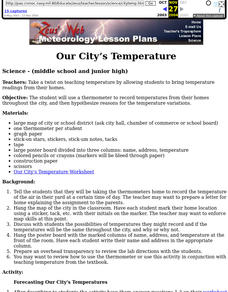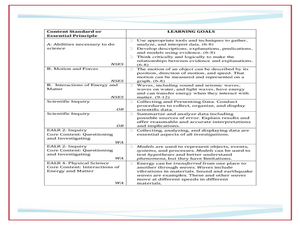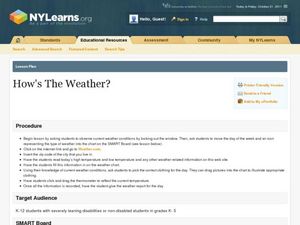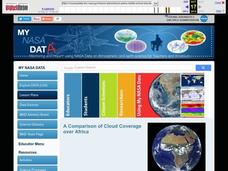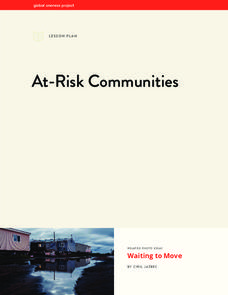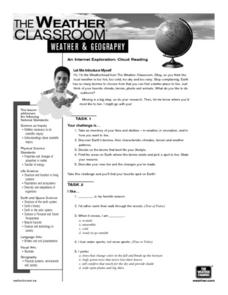Curated OER
Water Web
In this water web worksheet, students explore, analyze and discuss how weather stations interact with maintaining weather conditions and answer two essay questions and ten multiple choice questions.
Curated OER
Our City's Temperature
Middle schoolers use a thermometer to record temperatures from their homes throughout the city, and then hypothesize reasons for the temperature variations. They use a weather graph worksheet that's imbedded in this lesson to orgainize...
Curated OER
Weather
Pupils create a daily weather forecast including present temperature, high temperature, moon phase, sky watch, and occasional special reports dealing with weather phenomenon.
Curated OER
The Clouds Tell All
Students examine the different types of clouds and how they form. They are to create their own weather forecast based on their observations of clouds in their area. Questions are asked for comprehension to end the lesson.
Curated OER
Global Warming
This contains a writing prompt about global warming that could be adapted in a number of ways. The resource provides some information about global warming and possible effects. Learners explore the enhanced greenhouse effect and the...
National Wildlife Federation
When It Rains It Pours More Drought and More Heavy Rainfall
Which is worse — drought or flooding? Neither is helpful to the environment, and both are increasing due to climate change. The 16th lesson plan in a series of 21 covers the average precipitation trends for two different climates within...
Curated OER
Will It Rain Today or Tomorrow?
Students examine how to forecast weather. They examine the different types of weather and learn the correct vocabulary.
Curated OER
Too Heavy For Me
Students explore the different arrangement of air molecules in high and low air pressure masses. They compare the temperature of high and low pressure masses and discover how a barometer works.
Curated OER
Meteorological Predictions
Students make a link between prediction and hypothesis in math and science. Based on data collected over one week, students evaluate the predictions of local weather forecasters, compare the predicted outcomes to the actual weather...
NOAA
Ocean Currents
Go with the flow! The eighth installment in a 13-part series has earth science students dive in to the world's system of ocean currents. The interactive illustrates the different types and depths of currents, how wind and gravity...
Colorado State University
Why Does it Get Colder on a Clear Night than a Cloudy Night?
Clouds are nature's insulator! A lab investigation asks learners to use an infrared thermometer to measure differences in infrared temperatures. They find that pointing the thermometer at a cloud has a much different result than pointing...
Curated OER
Understanding Climate Change
The young scientists in your class will appreciate a resource about different elements of climate change. The packet includes factual materials, informational text, and clear visuals, perfect for sharing with your environmental...
Curated OER
Conditions at Sea Introductory Activity, Making Waves
Students explore waves and wind. In this physical and earth science wave instructional activity, students participate in a wave making activity with an aquarium and a hair dryer. Students complete a data chart recording wave height and...
Curated OER
Naming the Clouds
Fourth graders examine how water condenses into clouds and identify the different types of clouds using the same system devised over 200 years ago. They listen to a book about clouds, and create a Cloud Key. Next, they record their...
Curated OER
Meteorologist for a Day
Students research weather patterns, predict the weather for a US city and write a weather forecast that be presented to the class. The forecast should explain their weather prediction and the weather patterns and conditions it is based on.
Curated OER
How's the Weather
Students explore weather patterns. They collect and record all aspects of the weather from various sites. Students investigate regional weather and use a spreadsheet to record and chart data. Students chart temperature, humidity,...
National Wildlife Federation
Ghost Town
Around 93 percent of the reefs on Australia's Great Barrier Reef have been bleached, and almost one quarter of them are now dead. Scholars research the sea temperatures, especially around the areas with coral reefs, to make connections...
National Wildlife Federation
Citizen Science to the Rescue!
You don't have to be a scientist or even out of high school to contribute to scientific research. In the 12th lesson in the series of 21, scholars use this opportunity to add to the growing body of scientific knowledge and consider the...
Curated OER
A Comparison of Cloud Coverage over Africa
Students identify different climate regions and local weather patterns. In this cloud coverage lesson students use NASA satellite data and import it into Excel.
Curated OER
Looking at the Water Cycle
For this Looking at the Water Cycle worksheet, read an explanation of the water cycle and fill in missing words. Learners also create a poster about the water cycle, deliver a weather forecast, and research further questions.
Curated OER
Telecollaboration Lesson
Sixth graders explore the Caribbean sea and the Arctic ocean. They become familiar with the living conditions of others. Students investigate the geographic location of each area. They become familiar with important events that helped...
Global Oneness Project
At-Risk Communities
"Waiting to Move," a photo essay by Ciril Jazbec, brings into sharp focus the threats posed by climate change. Class members examine images of Shishmaref Island and the Native Alaskan Inupiate coastal villages that are impacted by rising...
Curated OER
Cloud Reading
Middle schoolers identify the biomes of the Earth and their characteristics. They discuss their favorite seasons and the weather. They share their favorites with the class.
Curated OER
Storm Clouds-- Fly over a Late Winter Storm onboard a NASA Earth Observing Satellite
Students study cloud data and weather maps to explore cloud activity. In this cloud data instructional activity students locate latitude and longitude coordinates and determine cloud cover percentages.
Other popular searches
- Weather Patterns
- Weather Forecasting
- Weather Patterns 1st Grade
- Predicting Weather
- Weather Prediction
- Weather Forecasting Symbols
- Global Weather Patterns
- Changes in Weather Patterns
- Climate Weather Patterns
- Recording Weather Patterns
- Heat and Weather Patterns
- Current Weather Patterns

